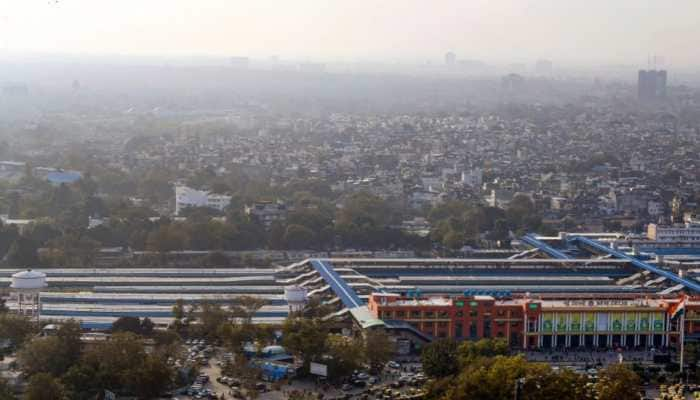Moody's affirms India's sovereign rating at 'Baa3' with positive outlook
Moody's Investors Service Wednesday affirmed India's sovereign rating at 'Baa3' with a positive outlook, saying it expects policymakers to continue reforms to achieve balanced growth and reduce the government's debt load.
Trending Photos
)
New Delhi: Moody's Investors Service Wednesday affirmed India's sovereign rating at 'Baa3' with a positive outlook, saying it expects policymakers to continue reforms to achieve balanced growth and reduce the government's debt load.
India had pitched hard with Moody's for a rating upgrade, but the US-based agency has maintained that it would wait for "tangible" benefits of reform initiatives before upgrading its sovereign rating.
"The policy effort has not delivered a sufficiently clear prospect of the reform dividends -- sustained, high growth and the promise of a reduction in the country's debt burden -- to support an upgrade," Moody's said as it affirmed India's 'Baa3' ratings while maintaining a 'positive' outlook.
The positive outlook denotes Moody's expectation that, over time, India's credit metrics will likely shift to levels consistent with a 'Baa2' rating.
"In particular, the outlook reflects our expectation that continued policy reform implementation will allow balanced growth to support a reduction in the government debt burden, currently a constraint on India's rating," it said.
Baa3 rating implies lowest investment grade -- just a notch above 'junk' status.
A broad range of policies have been implemented that are conducive to moderating inflation and limited current account deficits. A number of policy reforms, if effective, would lead to higher investment and more efficient savings, Moody's said.
The passage and ongoing implementation of a range of economic reform measures, including the goods and services tax and reform of the bankruptcy code, points to improvements in government effectiveness, it added.
"Policy reforms are still relatively recent with material uncertainty about the effectiveness of measures already implemented and whether momentum will sustain," Moody's said.
However, private investment has not picked up in response to the government's measures, denoting limited policy effectiveness.
Its assessment is investment has been constrained by high leverage in some sectors, a relatively unfavourable global environment and in some cases, limited access to finance. Businesses may have to wait for more certainty about the tangible implications of reforms on their operating environment.
The coordination and alignment of objectives between different parts of the government and the private sector poses implementation challenges, it added.
The sovereign rating and outlook for a country are often referred to as key parameters by foreign investors and global bodies to gauge its investment climate.
The banking sector, Moody's said, however continues to pose "material contingent liability risks to the sovereign".
"However, the reform effort to date has not yet achieved the conditions that would support an upgrade to Baa2, in particular in accelerating private investment to support high, stable growth, without which the government's debt burden -- a key constraint on the rating -- is likely to remain high for a sustained period," it said.
Moody's, which had raised India's outlook to positive from stable, said the asset quality, loan loss coverage and capital ratio of banks remain weak and this poses sovereign credit risks.
"While recognition of non-performing loans has largely been achieved, lack of resolution of impaired loans will continue to constrain India's sovereign credit profile until a viable resolution mechanism is put in place," it said.
Moody's further said India's rating is constrained by low per capita income, over dependence of farm sector on monsoon and high government debt.
On the revenue side, India's large low-income population limits the government's tax revenue base. At 20.9 percent of GDP in 2015, general government revenues were markedly lower than the 27.1 percent median for Baa-rated sovereigns.
Although the implementation of GST and other measures that are aimed at enhancing tax collection will help widen and boost revenues, the effect will only materialise over time and their magnitude is uncertain so far.
"As a result, the general government deficits will remain sizeable and any reduction in India's government debt burden will largely rely on robust nominal GDP growth. We expect that the debt-to-GDP ratio will hover around the current levels, at 68.6 percent in 2015, before falling gradually as nominal GDP growth is sustained and revenue-broadening and expenditure efficiency-enhancing measures take effect," it said.
Moody's said it will consider a rating upgrade on evidence that institutional strengthening will elicit sustained macro-economic stability, higher levels of investment and more favourable fiscal dynamics.
Evidence of institutional effectiveness will get reflected through revival in private investment, improving infrastructure, and/or additional policies to enhance India's economic and financial strength.
"These policies could include land or labour reforms by a significant number of states, the establishment of a credible and effective fiscal framework, complemented by measures to reduce expenditures or increase revenues, tangible progress in implementation of the bankruptcy law and a workable strategy to resolve banks' bad assets over the medium term," it said.
India's core credit strengths are its size and growth potential, which are among the highest of Moody's-rated sovereigns and provide key support to its 'Baa3' rating.
"Low incomes constrain India's sovereign credit profile by limiting the government's revenue base and adding to its social and development spending requirements," it said.
In an environment of lacklustre global trade which we expect to continue, India's very large domestic markets provide a relative competitive advantage compared to other, smaller and more trade-reliant economies.
As the economy shifts towards higher value-added and higher productivity growth, incomes will continue to rise faster than in most other economies. Combined with the very large size of the economy which prevents high concentration and hence vulnerability to sector-specific shocks, higher incomes will bolster economic resilience.
India's significantly reduced and now very low external vulnerability also contributes to resilience by sheltering the economy from abrupt changes in financing conditions.
Moody's, however, cautioned that it could revise India's rating outlook to stable if economic, fiscal and institutional strengthening appeared unlikely, or banking system metrics remained weak or balance of payments risks rose.
Moody's said the decision to maintain a positive outlook on the Baa3 rating rather than assigning a stable outlook was driven by economic and institutional reforms that continue to offer a reasonable expectation that India's growth will outperform that of its peers over the medium term and expectations that further improvements in its macro-economic and institutional profile will be achieved.
Stay informed on all the latest news, real-time breaking news updates, and follow all the important headlines in india news and world News on Zee News.
Live Tv







)
)
)
)
)
)
)
)
)
)
